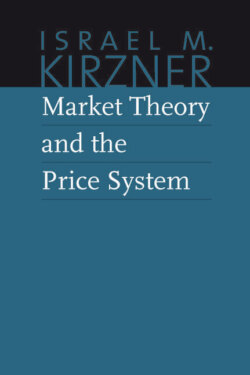Читать книгу Market Theory and the Price System - Israel M. Kirzner - Страница 50
На сайте Литреса книга снята с продажи.
Total Utility and Marginal Utility
ОглавлениеFor a cardinal utility theorist, we have seen, the term “marginal utility” is used in contradistinction to “total utility.” Total utility refers to the quantity of (cardinal) utility afforded by a stock of a commodity. Marginal utility refers to the rate at which total utility changes as the size of the stock of the commodity changes. An approximation to this rate of change of total utility is given by the amount of change in that utility resulting from a one-unit increase in the stock of the commodity. (Sometimes cardinal utility theorists loosely refer to this approximation as “marginal utility.”)4
For ordinal utility theory, such a distinction between total and marginal utility is not called for. Since there is no cardinal quantity of utility that increases, there can be no such concept as a rate of change of such a quantity. For an ordinal theory, marginal utility means the significance attached to the addition to (or decrease of) the quantity possessed of a good by the marginal unit. It does not, it must be noticed, refer to a change in the significance of the stock of the good, but to the significance of a change in the size of the stock. But total utility, too, for the ordinal theorist means the significance attached to the acquisition or loss of a given stock of the commodity. Both the utility of a stock of a good and the marginal utility of a marginal unit being added (or subtracted) from the stock “are total utilities” (in that they do not refer to “rates of change”); but, and more important, at the same time they are both “marginal utilities” in the sense that the utility of any quantity of a good, large or small, implies that this quantity is being considered “marginally”—that is, that somebody is contemplating the acquisition or loss of this quantity.
The “marginal unit,” in fact, is never anything else than the unit that happens to be under consideration. It is the unit relevant to the act of choice confronting a man. The size of this unit depends only on the circumstances of the situation where a choice has become necessary. A man may be contemplating the purchase of several shirts. For certain sums of money, he can buy one, two, or several shirts. In choosing among the alternatives open to him, the man will be comparing the marginal utilities of the appropriate number of shirts—that is, the smallest number of shirts separating one possible decision from another. If any number of shirts can be bought, then a single shirt is the marginal unit; if shirts can be bought only in packages of three, then three shirts make up the marginal unit—and the decision whether or not to buy additional shirts will involve the difference that three more shirts will make to the purchaser’s sense of well-being. Suppose a situation where a man is forced to choose between purchasing all of a supply of shirts or of obtaining none at all; then the entire supply would be the relevant “unit.” The man must assess the difference that the entire supply would mean to him in considering the attractiveness of the price it can be had at. In such a situation the marginal unit is the entire supply, and the man is in a position where the “marginal utility of shirts” means nothing else than the significance to him of this entire shirt supply.
